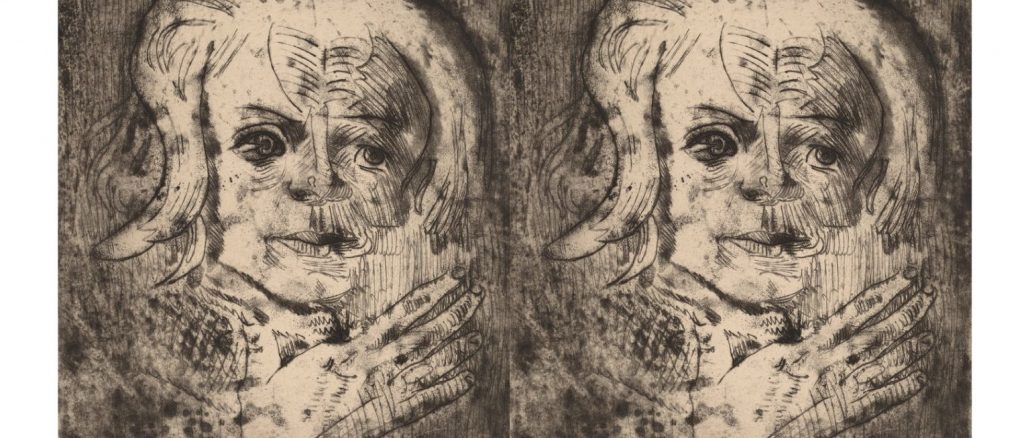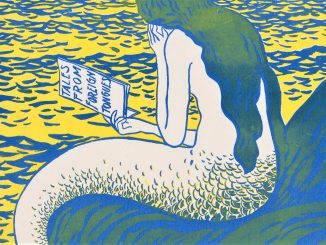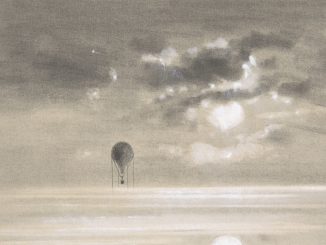
I drive in the late night darkness to the local emergency room with my mother. I have never been there before; it is only a clinic, but it is close by and open all night. I have left my husband at home, sound asleep for the few hours he has in a brutal work schedule. I have gently lifted the baby from his position snuggled in bed next to me and buckled him, still sleeping, into his car seat.
My mother had been helping in the garden. A hands-on kind of mother visiting Seattle from California, she decided earlier that day to tackle the ivy. In the back, masses of ivy, rampant and dense, spread up and out between shrubs and trees. My mother hates ivy. Too big, too strong, too invasive. She had been struggling with the tangled vines and thick leaves in rubber flip flops, exposed feet wading in the secretive undergrowth, when she felt the bite. Together, before the easy promiscuity of the Internet, we examine the foot. We determine that it must have been a spider. The foot swells, engorging to double its usual size. Images of deadly venom, of blood infection, of red streaks making their way up to the heart, come to mind. I make an executive decision. We must see a doctor, just in case. My mother has always taken care of me, worried about me, protected me. Now a mother myself, it is my turn.
As we drive together, it seems as if everyone in the quiet suburb sleeps cocooned in houses behind closed curtains and lowered shades, a sensation that makes our journey feel mystical, as if we are the only people alive, the car a kind of space ship exploring uninhabited territory. Thick clusters of tall pine trees and large clumps of shrubbery pass by monotonously in the silent night. I have learned in my years in the Northwest that this landscape, coupled with consistently grey skies, can feel oppressive, almost claustrophobic. Tonight the sky, which has been overcast all day, has darkened even further into an impenetrable blackness overhead. Only the headlights brighten the road in front of us.
Suddenly the high beams alight on a bundle in the middle of the pavement. I slam on the brakes. What is it? A garbage bag? A discarded piece of clothing? And then, for one horrifying instant–an infant in a blanket? But no, squinting into the headlamps’ bright trajectory I see it is a cat lying on its side. Weakly, it lifts its head to confront this latest threat–the car with its thrumming engine and blinding lights. The cat cannot move. It has been run over, left on the road, in the darkness, alone and helpless. I can see that it is hurt, wounded somewhere, immobilized in the middle of a dark road on a dark night. I do not know what to do. What if another car driving faster than mine doesn’t have time to stop and runs over the cat? What if another driver, distracted by radio dials or sleepiness, doesn’t see the cat at all before it’s too late? I pull over to the side of the street.
Putting the car in park and leaving the engine running to keep the heater on for my mother and my baby, I get out and tentatively approach the cat, trying to soothe it from a distance by murmuring, incantation-like, “it’s okay…it’ll be okay…you’ll be alright,” almost as I would if my child was distressed. But with the sight of my approach the cat, rendered feral with pain and fear, lifts its head again and hisses violently, fur electrified, fangs exposed. Hmm, I think, this isn’t going to work. Returning to the car, I feel the compounded pressure of my baby in the back seat, still sleeping, my mother beside me, possibly with blood poisoning, and now this cat in front of me, suffering and vulnerable.
Feeling helpless, I guide the car slowly on the shoulder of the road. Maneuvering around the cat, I give it wide berth, finally leaving it behind in the wake of our darkness as we continue to the 24-hour fluorescence of the emergency room.
***
My sense of impotence takes me back in time three years to Boston in the summer. It is the fourth of July. People, like my husband and I, amble and stroll in the balmy evening on their way to and from restaurants and bars, ice cream parlors and parties. The atmosphere is festive, relaxed. On the sidewalk, we catch up, unintentionally, to a family heading in the same direction as we. An all American family. There is the father: blonde, tall, barrel chested. Wearing a Hawaiian vacation shirt and pale linen slacks. There is the wife: also blonde, but petite and delicately boned. Wearing a flower patterned skirt and kitten heeled sling-backs. There is the daughter: about eleven. A gangly, gawky, awkward eleven. Long skinny legs and knobby knees, cotton dress and summer cardigan, sandals.
I take this all in subconsciously as we follow the family–each couple, each clique, each group in the crowd forming their own circle of intimacy, of conversation, of interaction. As we get nearer to the family, I hear the father. I see the father. I witness the father.
In one sweeping motion, without observable motivation, the father grabs the daughter by the neck, the older daughter, the eleven-year-old daughter, by the thin long neck, the neck with a nape, tender and pale, exposed between two blonde braids. The father throws the daughter against the brick wall of an adjacent building. I can still see the large meaty hand encircling the slim young neck, a neck caught off guard; I can still see the daughter, a girl startled, dismayed, scared. Her head bounces against the brick with the impact. The father presses the daughter up until she dangles from his hand. The girl clutches convulsively at her father’s arm in an instinctive attempt to loosen his suffocating grip. I hear the mother pleading in a soft high voice, “David! Stop …. David!” to no avail. He does not hear her; he does not heed her.
I have stopped–to watch, to witness–horrified and sickened. I want so badly to intervene, to rescue, to save the young girl. This father, this man, is like a figure in a Stephen King story, in a horror movie. The kind where the most normal, the most natural, the most conventional figure is nauseatingly transformed–skin melting into a monster, a brute, a beast. The girl, the victim, humiliated and shamed and frightened, never has a chance.
My husband senses my desperation to intervene, to yell out, to scream for an end to the abuse. “Let’s go,” he says, “We can’t do anything about it. He can beat us up if we say something.” I recognize, but reluctantly, painfully, helplessly, that he is right, that we cannot act without jeopardizing ourselves. Before cell phones, we cannot take a video as evidence; we cannot dial 911 and, as with the magic lamps of myths and legends whose rubbing conjures omnipotent genies to do one’s bidding, summon the police out of thin air. I wish for super hero powers, for bionic arms that can rescue, for an invincible body that can protect, for the strength to lift the bully by his neck and casually toss him aside, for the ability to catch the girl, to hold her, to comfort her. But instead, I can only refuse to leave before the scene somehow resolves itself, can only hover mutely at the periphery, bearing silent witness for this young girl, wishing desperately to be able to do something, to say something, but left only with the frustration of the powerless and the dumb.
When the father lets go, finally, the daughter falls to the ground, one hand still clutching at her neck. As she rights herself, shakily, her mother picks up the shoe that, loosening with the impact of the girl’s body against the wall, has tumbled off and puts it, quickly, nervously, back on her daughter’s foot. Then the family continues to walk toward their destination, blending into the weekend crowds as if nothing untoward has happened. But before they disappear, I see the father’s hand placed once again on the daughter who is walking with shoulders hunched and head bowed, this time pressing heavily on the exposed nape of the slender neck as he propels her forward–a weight, a warning, a guarantee of her continued submission.
What imprints itself forever on my memory like a tattoo’s indelible ink, what brands itself with the searing finality of a deep scar on my brain, is the shoe–a young girl’s sandal, fallen, temporarily forgotten, abandoned on the sidewalk.
***
Arriving at the clinic, I park the car in the patient loading zone, the space closest to the sliding doors. I tell my mother that I can’t stop thinking about the cat. “While you go inside and talk to a doctor, why don’t I go back and see if there’s some way to help?” My mother agrees, also concerned for the injured animal. I watch as she hobbles gingerly through the glass doors when they open automatically for her, then wait until she returns to the entryway and gives me a thumbs up—yes, a doctor can see her…yes, I can go now.
Back at the wounded cat, I park on the shoulder of the street, lights aimed at the indistinct mound to warn drivers to be aware as they drive down the road. It is in the early days of cell phones so I am able to call 411 for the numbers of all the agencies I can think of that might be able to help. I try the Humane Society—closed. I try WildCare—nothing. I try the local police—they tell me to call the Humane Society. I try the Human Society again—still no answer. Desperate, I try the police station one more time. I tell them the plight of the cat, who, mad with pain and confusion, hisses and snarls when approached, and my plight as the witness, the bystander, who wants to intervene, who wants to rescue, who wants to prevent further damage or possible death but does not know how. The police agree to come. Reassured, I sit in the car, my baby still asleep in the back seat, high beams cutting through the darkness, staring at the cat. Several cars come by and my plan works—the lights alert them to avoid the animal lying on the road.
When the two policemen arrive, I greet them through my window as I would an army of Good Samaritans, paramedics at a crash site, or a search and rescue team in an avalanche. They open the trunk of the black and white vehicle where they have thick gloves and a container. Together they approach the cat. The one with the gloves gently picks it up as the other positions the cage. I am gratified to hear one of them speak soothingly to the cat. “Hey there buddy…. Don’t worry, we got you.” After settling the container carefully in the back seat of the police car, they return to my window and thank me for my efforts on behalf of the cat. Thank you, I think. Thank you for helping me make a difference.
Relieved, a burden lifted off my shoulders, a weight off my mind, I make a U Turn toward the clinic where my mother is waiting for me, waiting for me to pick her up, waiting for me to hear the good news that her foot will be okay, waiting for me to take her and her grandchild home to the shelter and safety and security of warm rooms and soft beds, all threats and dangers retreating with the fading of the night and the lightening of the sky.
MARIANNA MARLOWE lives in the San Francisco Bay Area. After devoting many years to academic writing, her focus now is creative nonfiction that explores issues of gender identity, motherhood, feminism, cultural hybridity, and more. Her short memoir has been published in Hippocampus, Motherwell, Raising Mothers, Mutha Magazine, FORTH Magazine, and the Same, and she is currently at work on a memoir in vignettes titled Portrait of a Feminist.
Featured image: Walter Gramatté, “Girl with Hand,” etching on laid cream paper, 1923. Gift of Ruth Cole Kalnen. National Gallery of Art.


